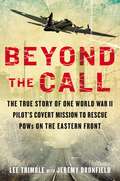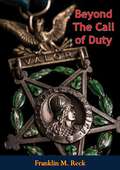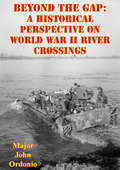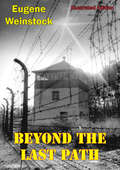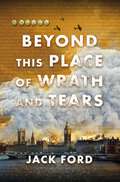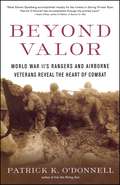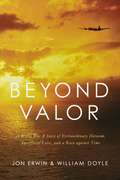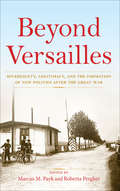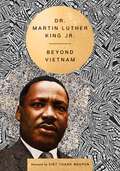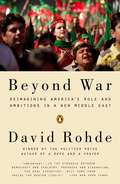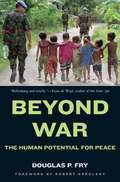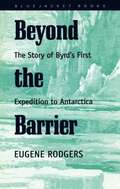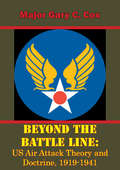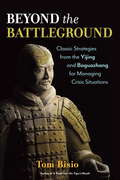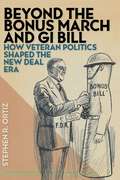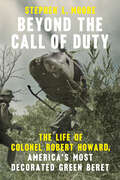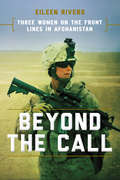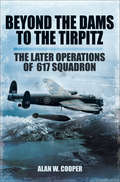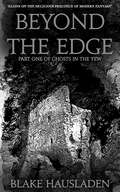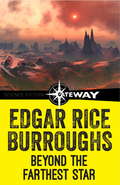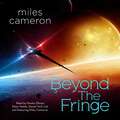- Table View
- List View
Beyond That, the Sea: A Novel
by Laura Spence-Ash“Spence-Ash has written the novel in eight points of view, but each character is utterly three-dimensional and distinct. This debut novel captivated me from start to finish."—Julia Quinn, author of the Bridgerton Series A sweeping, tenderhearted love story, Beyond That, the Sea by Laura Spence-Ash tells the story of two families living through World War II on opposite sides of the Atlantic Ocean, and the shy, irresistible young woman who will call them both her own.As German bombs fall over London in 1940, working-class parents Millie and Reginald Thompson make an impossible choice: they decide to send their eleven-year-old daughter, Beatrix, to America. There, she’ll live with another family for the duration of the war, where they hope she’ll stay safe.Scared and angry, feeling lonely and displaced, Bea arrives in Boston to meet the Gregorys. Mr. and Mrs. G, and their sons William and Gerald, fold Bea seamlessly into their world. She becomes part of this lively family, learning their ways and their stories, adjusting to their affluent lifestyle. Bea grows close to both boys, one older and one younger, and fills in the gap between them. Before long, before she even realizes it, life with the Gregorys feels more natural to her than the quiet, spare life with her own parents back in England.As Bea comes into herself and relaxes into her new life—summers on the coast in Maine, new friends clamoring to hear about life across the sea—the girl she had been begins to fade away, until, abruptly, she is called home to London when the war ends.Desperate as she is not to leave this life behind, Bea dutifully retraces her trip across the Atlantic back to her new, old world. As she returns to post-war London, the memory of her American family stays with her, never fully letting her go, and always pulling on her heart as she tries to move on and pursue love and a life of her own.As we follow Bea over time, navigating between her two worlds, Beyond That, the Sea emerges as a beautifully written, absorbing novel, full of grace and heartache, forgiveness and understanding, loss and love.
Beyond The Call
by Lee Trimble Jeremy DronfieldNear the end of World War II, thousands of Allied ex-POWs were abandoned to wander the war-torn Eastern Front, modern day Ukraine. With no food, shelter, or supplies, they were an army of dying men.The Red Army had pushed the Nazis out of Russia. As they advanced across Poland, the prison camps of the Third Reich were discovered and liberated. In defiance of humanity, the freed Allied prisoners were discarded without aid. The Soviets viewed POWs as cowards, and regarded all refugees as potential spies or partisans.The United States repeatedly offered to help recover their POWs, but were refused. With relations between the allies strained, a plan was conceived for an undercover rescue mission. In total secrecy, the OSS chose an obscure American air force detachment stationed at a Ukrainian airfield; it would provide the base and the cover for the operation. The man they picked to undertake it was veteran 8th Air Force bomber pilot Captain Robert Trimble.With little covert training, already scarred by the trials of combat, Trimble took the mission. He would survive by wit, courage, and a determination to do some good in a terrible war. Alone he faced up to the terrifying Soviet secret police, saving hundreds of lives. At the same time he battled to come to terms with the trauma of war and find his own way home to his wife and child.One ordinary man. One extraordinary mission. A thousand lives at stake.This is the compelling, inspiring true story of an American hero who laid his life on the line to bring his fellow men home to safety and freedom.INCLUDES PHOTOS
Beyond The Call of Duty
by Franklin M. ReckTHE Medal of Honor is the highest decoration for bravery in battle awarded by the United States. It is frequently called the Congressional Medal of Honor, though the word “Congressional” doesn’t properly belong in the title.All citations for the Medal of Honor contain some variant of the following words:“For conspicuous gallantry and intrepidity involving risk of life above and beyond the call of duty in action with the enemy.”This book tells the stories of those first sixteen, plus two Army Air Force officers who won their decorations in a ground action during an infantry attack. Two of the winners in this book are Cavalry—jeep-mounted cavalry operating with the infantry during the Sicilian campaign.These men received the Medal of Honor, first of all, because their most intimate comrades thought they deserved it. A recommendation for a Medal of Honor begins on the field of action, with fellow soldiers who saw or shared in the exploit.
Beyond The Gap: A Historical Perspective On World War II River Crossings
by Major John OrdonioCrossing a river against a defending enemy force is a difficult and complex task for any army. History has shown that preparation is necessary to avoid disasters during this type of operation. In 2003, the Third Infantry Division crossed the Euphrates River because it was prepared for this task and possessed the necessary equipment. Since then, no other divisions or corps has executed river crossing operations.While the United States Army focused on counterinsurgency operations during the last twelve years, it underwent significant changes to adapt to meet the adversities on the battlefield. It transformed its war-fighting organizations, trained its corps and divisions with computer simulations, and relegated field training to brigade and below units. In addition, its current doctrine now refers to river crossings as the deliberate wet gap crossing. Because of these changes, many questions arose as to the present corps and divisions' preparedness to do large-scale operations, to include its ability to plan, prepare, and execute the deliberate wet gap crossing. If called today, could these organizations conduct this complex operation? Examining river crossings in Europe during the Second World War was appropriate for insight into how the previous generation of corps and divisions prepared and executed such a complex task. After analyzing how these units were able to cross the numerous waterways in Europe, the present Army should consider reassessing its doctrine, training, and organization and equipment to prepare its units for future deliberate wet gap crossings.
Beyond The Last Path [Illustrated Edition]
by Eugene WeinstockIncludes 204 photos, plans and maps illustrating The HolocaustThis is the story of No. 22483, who had been shipped from Belgium to Buchenwald. This is an account of what No. 22483 saw and felt during his calvary from Antwerp to the Malin distribution camp in France and from there to the extermination camp of Buchenwald.To say that this book contains the scenes of a twentieth-century Inferno may sound commonplace. Yet, every page of this book reminds one of Dante's Inferno, with one exception: the Inferno the author writes about consumed the lives not of the sinful whom divine justice cast into the immortality of suffering.This Inferno was thronged by millions, many of whom were babies and little children, mothers and young women who had hoped to become mothers. It was thronged with people who deserved their fates because they were men in the sense that God meant them to be. They were in Inferno because they were strong men and brave, the real heroes of our days. They were doomed because the Nazi super-race set up a different scale of values which regarded heroism as the greatest of sins and considered depravity the greatest of virtues. Reading this book one feels that the titanic Dante himself would have been staggered by the demented criminality the judges of the just displayed.This is the story of No. 22483 of Buchenwald, one of the millions who were doomed and one of the few who escaped. Throughout, the writing is poignant, vibrant with humanity, a cry "de profundis" and a vow that it must never happen again. This book should be long remembered.
Beyond The Wall
by Christa LairdAn escape route through the sewers of Warsaw Ghetto has led Misha to the partisans on the other side of the wall. Yet as he tried to cheat and beat the Nazi regime, he finds his nerve-racking new existence spiked with as much fear and danger as the past. Misha is playing a deadly game, but the prize is his life...
Beyond This Place of Wrath and Tears
by Jack FordFrom award-winning journalist Jack Ford, a riveting and colorful dual timeline novel of Lee Carson, the heroic yet elusive female journalist who defied convention and danger to report from the front lines of WWII, combining breathtaking wartime narrative with a compelling Cold War espionage tale for fans of Christine Mangan, Pam Jenoff, Erika Robuck, and Kate Quinn. Washington, DC, April 1954: Lee Carson, former war correspondent, is frustrated that her journalism career has been relegated to society events and fashion stories. But when she receives a tip about a Russian spy in a high-ranking government position at the height of the Cold War, she feels the thrill of a story that she hasn&’t felt since she was on the front lines of the European theater . . . London, December 1943: As war rages on across Europe, twenty-two-year-old Lee Carson is waging a private battle of her own. An American-born correspondent for the International News Service, Lee is determined to cover the war from the field. But no woman, certainly not an attractive young woman with no military experience, will be allowed near the front lines. Lee is not easily dissuaded. And as the Allied forces prepare to take the fight to the enemy, her gift for boosting public morale is seen as a valuable weapon. Assigned to cover the build-up to the invasion of Nazi-held Europe, she constantly wrangles with authorities to get to the heart of the action. From talking herself onto a bomber and flying over the beaches of Normandy at the start of D-Day to other feats of daring, she witnesses and reports on the war&’s most pivotal moments. Told in dual timelines, Beyond this Place of Wrath and Tears is inspired by the story of an incredible woman who has largely been forgotten by history, and who, like many women in WWII, broke barriers in wartime only to find that upon the return home, she had to continue to fight for relevance in an entirely different way . . .
Beyond Valor
by Patrick K. O'DonnellPrevious books have promised to describe the combat experience of the World War II GI, but there has never been a book like Patrick O'Donnell's Beyond Valor. Here is the first combat history of the war in Europe in the words of the men themselves, and perhaps the most honest and brutal account of combat possible on the printed page. For more than fifty years the individual stories that make up this narrative -- shockingly frank reflections of sacrifice and courage -- have been bottled up, buried, or circulated privately. Now, nearing the ends of their lives, our WWII soldiers have at last unburdened themselves. Beyond Valor recaptures their hidden history. A pioneering oral historian, Patrick O'Donnell used his award-winning website, The Drop Zone, to solicit oral- and "e-histories" from individual soldiers. Gradually, working from within the community, O'Donnell convinced some of the war's most battle-hardened soldiers to tell their stories. The result is WWII seen through the eyes of the men who saw the most intense of its action. O'Donnell focuses on the elite units of the war -- the Rangers, Airborne, and 1st Special Service Force -- troops that spearheaded the most dangerous operations and often made the difference between victory and defeat. From more than 650 interviews O'Donnell has chosen oral- and e-histories that form a seamless story line, a pointillistic history of the war in Europe from the first parachute drops in North Africa through the final battles in Germany and the long trip home. It is the story of the war not discussed in polite company. O'Donnell presents the wreckage of entire battalions nearly annihilated, invisible personal scars, and haunting revelations of wartime atrocities. But more important are the men who recount lives risked without hesitation for comrades and cause, and those who did not return: the friends who died in their arms. Their stories remind all of us that victory came only at the highest price. Remembering the infamous cliffs at Pointe-du-Hoc, bloody Omaha Beach, the bitter fighting at the Battle of the Bulge, and Hill 400 in the Hürtgen Forest, the soldiers reveal war as seen, heard, and smelled by the GIs on the front line. Also included is the unique story of the 555th Parachute Infantry Battalion, and the trailblazing African-American "Experimental" Test Platoon that had to fight its own battle behind the lines. Beyond Valor captures the truths that exist among soldiers. It is one of the most inspiring accounts of the war ever produced.
Beyond Valor: A World War II Story of Extraordinary Heroism, Sacrificial Love, and a Race against Time
by William Doyle Jon ErwinBeyond Valor is one soldier&’s extraordinary tale of bravery, heroism, faith, and devotion."Amazing...A thrilling and poignant story of patriotism that all Americans can be stirred, moved, and encouraged by." -- Gary SiniseOn April 12, 1945, a fleet of American B-29 bombers flew toward Japan. Their mission was simple: stop World War II by burning the cities, factories, and military bases of the Japanese empire, thereby forcing an unconditional surrender. Yet the mission did not go as planned. On board one of the B-29s, the City of Los Angeles, a phosphorus bomb detonated inside the plane. Staff Sergeant Henry E. &“Red&” Erwin absorbed the blast of burning phosphorus yet managed to throw overboard the still-flaming bomb, before collapsing from the third-degree burns over much of his body.Breaking protocol, the plane diverted to a military hospital at Iwo Jima. President Truman quickly ordered that Erwin be awarded the Medal of Honor, the highest honor of the American military, before the young airman died of his wounds. There was just one problem: no Medals of Honor were available in the entire Pacific theater. General Curtis LeMay dispatched a squad of airmen on a 1,000-mile mission to smash their way into a display case and steal a medal to give to Erwin before time ran out.Meanwhile, Red&’s courageous young bride set out on her own mission, one of against-all-odds healing. Her success would determine the fate of the twenty-three-year-old warrior--and years later make possible the birth of the book's author: their grandson, Jon Erwin.Drawn from in-depth interviews with eyewitnesses and deep archival research, Beyond Valor is an extraordinary tale of bravery, heroism, faith, and devotion.
Beyond Versailles: Sovereignty, Legitimacy, and the Formation of New Polities After the Great War
by Edited by Marcus M. Payk and Roberta PergherTen essays analyzing the history and effects of the Paris Peace Conference following World War I. The settlement of Versailles was more than a failed peace. What was debated at the Paris Peace Conference of 1919–1920 hugely influenced how nations and empires, sovereignty, and the international order were understood after the Great War?and into the present. Beyond Versailles argues thatthis transformation of ideas was not the work of the treaty makers alone, but emerged in interaction with nationalist groups, anti-colonial movements, and regional elites who took up the rhetoric of Paris and made it their own. In shifting the spotlight from the palace of Versailles to the peripheries of Europe, Beyond Versailles turns to the treaties&’ resonance on the ground and shows why the principles of the peace settlement meant different things in different locales. It was in places a long way from Paris?in Polish borderlands and in Portuguese colonies, in contested spaces like Silesia, Teschen, and Danzig, and in states emerging from imperial collapse like Austria, Egypt, and Iran?that notions of nation and sovereignty, legitimacy, and citizenship were negotiated and contested.&“This is an excellent collected volume, well-conceived and very well written. . . . This is not at all a top-down history of the diffusion of ideas about national self-determination. Rather, it is an examination of the ways in which these ideas were taken up, re-fashioned, and reasserted at many levels to serve local and regional agendas, while at the same time influencing international debates about the meanings and possible implementations of self-determination.&” —Pieter M. Judson, author of The Habsburg Empire: A New History
Beyond Vietnam (The Essential Speeches of Dr. Martin Lut #3)
by Dr. Martin Luther King Jr.With a new foreword by Viet Thanh NguyenA beautiful commemorative edition of Dr. Martin Luther King's speech "Beyond Vietnam,” part of Dr. King's archives published exclusively by HarperCollins.At New York City's Riverside Church in 1967, Dr. King stood in front of a rapt audience and criticized the Vietnam War as a destructive act of force and a cruel manipulation of the poor—for those fighting on either side. He urged Americans to confront the harsh realities of war and consequently pursue a path where everyone is presented a choice, in his words, "a choice of nonviolent coexistence instead of violent coannihilation.”This beautifully designed hardcover edition presents Dr. King’s speech in its entirety, paying tribute to this extraordinary leader and his immeasurable contribution, and inspiring a new generation of activists dedicated to carrying on the fight for justice and equality.
Beyond War
by David RohdeThe Pulitzer Prize-winning author examines the cardinal failing of Washington's war on terror This book distills eleven years of expert reporting for The New York Times, Reuters, and The Atlantic Monthly into a clarion call for change. An incisive look at the evolving nature of war, Rohde exposes how a dysfunctional Washington squandered billions on contractors in Iraq and Afghanistan, neglected its true allies in the war on terror and failed to employ its most potent nonmilitary weapons: American consumerism, technology, and investment. Rohde then surveys post-Arab Spring Tunisia, Turkey, and Egypt, and finds a yearning for American technology, trade, and education. He argues that only Muslim moderates, not Americans, can eradicate militancy. For readers of Steve Coll, Tom Ricks, and Ahmed Rashid, Beyond War shows how the failed American effort to back moderate Muslims since 9/11 can be salvaged.
Beyond War
by David RohdeA groundbreaking look at America's role in the Middle East--from the Pulitzer Prize-winning author of A Rope and a PrayerDistilling eleven years of expert reporting for the New York Times, Reuters, and the Atlantic, two-time Pulitzer Prize winner David Rohde presents an incisive look at the calamitous privatization of the war on terror. Beyond War is a clarion call for change in American policies and attitudes toward a rapidly changing Middle East. Rohde argues that using lethal force is necessary at times, but economic growth and Muslim moderates --not American soldiers--will eradicate militancy in the long term. Vast mistakes have been made, but it is not too late. By scaling back our ambitions, focusing on economics and working with Muslim moderates, we will achieve more.
Beyond War: The Human Potential for Peace
by Douglas P. FryA profoundly heartening view of human nature, Beyond War offers a hopeful prognosis for a future without war. Douglas P. Fry convincingly argues that our ancient ancestors were not innately warlike--and neither are we. He points out that, for perhaps ninety-nine percent of our history, for well over a million years, humans lived in nomadic hunter-and-gatherer groups, egalitarian bands where warfare was a rarity. Drawing on archaeology and fascinating recent fieldwork on hunter-gatherer bands from around the world, Fry debunks the idea that war is ancient and inevitable. For instance, among Aboriginal Australians, warfare was an extreme anomaly. Fry also points out that even today, when war seems ever present, the vast majority of us live peaceful, nonviolent lives. We are not as warlike as we think, and if we can learn from our ancestors, we may be able to move beyond war to provide real justice and security for the world.
Beyond the Balance of Power
by Peter JacksonThis is a major new study of French foreign and security policy before, during and after the First World War. Peter Jackson examines the interplay between two contending conceptions of security: the first based on traditional practices of power politics and the second on internationalist doctrines that emerged in the late nineteenth century. He pays particular attention to the social and political context in which security policy was made and to the cultural dynamics of the policy-making process. The result is a comprehensive reassessment of France's security policy in the era of the Great War. The book reconsiders the evolution of French war aims and reinterprets the peace policy of the Clemenceau government in 1919. It also provides a new perspective on the foreign policy of successive French governments in the early 1920s. It shows that internationalist ideas were far more influential over this entire period than is commonly understood.
Beyond the Barrier
by Eugene RodgersWithout discrediting the expedition's success or Admiral Richard Byrd's leadership, this book makes clear for the first time that the admiral was not the saintly hero he and the press depicted. A provocative reassessment of an American hero, but a scrupulously objective book that makes a major contribution to history.
Beyond the Battle Line: US Air Attack Theory and Doctrine, 1919-1941
by Major Gary C. CoxThis study examines the development and usefulness of US air attack theory and doctrine during the interwar period, 1919-1941. This period represents more than twenty years of development in US Air Corps attack theory and doctrine. It was the first peacetime period of such development. Attack aviation during this time was a branch of aviation used to provide direct and indirect combat support to ground forces in the form of machine gun strafing, light bombing, and chemical attacks.From the earliest origins, attack theory and doctrine evolved primarily along two paths direct and indirect support of ground and air force objectives. The direct support approach was based on fundamental beliefs by the Army that attack aviation was an auxiliary combat arm, to be used directly on the battlefield against ground forces and to further the ground campaign plan.The indirect support approach, or air interdiction, was derived from the fundamental beliefs by the Air Corps that attack aviation was best used beyond the battle line and artillery range, against targets more vulnerable and less heavily defended, to further both the Air Force mission and the ground support mission.As attack doctrine evolved, range and hardened targets became problematic for the single-engine attack plane.Thus, attack theory and doctrine in terms of the indirect support approach, was adequately developed to be useful at the start of WWII. The use of light and medium bombers in North Africa showed the effectiveness of air interdiction and the indirect approach. Attack aviation had, indeed, established itself before WWII. Attack aviation, in the form of close air support, would have to wait for the lessons of WWII.
Beyond the Battleground
by Tom BisioDrawing on ideas from classical military strategy, the Yijing (Book of Changes), and Chinese martial arts theory, Tom Bisio presents a fascinating exploration of how insights from these sources can be deployed to manage crisis situations in all aspects of our daily lives. Suggesting approaches for cultivating a strategic mindset that can be applied to one's relationships, work, and personal self-fulfillment, Beyond the Battleground offers methods of adapting to circumstances, conserving one's own resources, and avoiding or dissolving conflict that will aid any reader navigating the uncertainties of the changing world, including the business person, military theorist, or martial artist. Deftly interweaving his background in East Asian philosophy and history and his career in traditional Chinese medicine with his lifelong interest in the martial arts and military science, Bisio also presents examples of successful strategies from history's great commanders such as Sunzi, Alexander the Great, Napoleon, and Mao Zedong.From the Trade Paperback edition.
Beyond the Bonus March and GI Bill: How Veteran Politics Shaped the New Deal Era
by Stephen R. OrtizThe period between World Wars I and II was a time of turbulent political change, with suffragists, labor radicals, demagogues, and other voices clamoring to be heard. One group of activists that has yet to be closely examined by historians is World War I veterans. Mining the papers of the Veterans of Foreign Wars (VFW) and the American Legion (AL), Stephen R. Ortiz reveals that veterans actively organized in the years following the war to claim state benefits (such as pensions and bonuses), and strove to articulate a role for themselves as a distinct political bloc during the New Deal era.Beyond the Bonus March and GI Bill is unique in its treatment of World War I veterans as significant political actors during the interwar period. Ortiz’s study reinterprets the political origins of the "Second" New Deal and Roosevelt’s electoral triumph of 1936, adding depth not only to our understanding of these events and the political climate surrounding them, but to common perceptions of veterans and their organizations. In describing veteran politics and the competitive dynamics between the AL and the VFW, Ortiz details the rise of organized veterans as a powerful interest group in modern American politics.
Beyond the Call of Duty: The Life of Colonel Robert Howard, America's Most Decorated Green Beret (American War Heroes)
by Stephen L. MooreAs a child, Robert Howard was taught by his Granny Callie to always face his threats head-on. Some thirty years later, he emerged from the Vietnam War as America&’s most decorated Green Beret.For the first time, Robert Howard&’s story is being told in full. Respected military historian Stephen L. Moore takes readers into the heart of the Vietnam War's covert Special Ops jungle warfare in this immersive, suspenseful read. Through family sources, National Archives documents, and dozens of testimonials from the Green Berets who fought alongside him, this &“one-man army&” will finally be given the recognition he deserves.Robert Howard grew up in poverty in a small town in Alabama, with a strong sense of faith and determination. When he enlisted in the army at age seventeen, his Granny Callie&’s words echoed in his head, and he pledged to follow them to the bitter end. In the most dire of combat experiences, Howard ran directly toward his opponents, sacrificing his body to protect others and to complete the mission above all else. Time and time again, he survived battles that should have claimed his life, suffering countless bullets, a spinal injury, and shrapnel and blast wounds. Recon commanders who ran missions with him declared him to be the bravest man they had ever met.In return, Howard received a staggering number of awards and ribbons for valor and distinctive service in combat—over fifty in all, including the Medal of Honor, eight Purple Hearts, the Distinguished Service Cross, a Silver Star, and four Bronze Stars. He holds the distinction of being the only soldier nominated for the Medal of Honor three times in only a thirteen-month period. In total, Howard spent a grueling, treacherous forty months in combat duty in Vietnam, including over two years with MACV-SOG&’s elite covert group.
Beyond the Call: Three Women on the Front Lines in Afghanistan
by Eileen RiversA riveting account of three women who fought shoulder-to-shoulder with men and worked with local women to restore their lives and push back the TalibanThey marched under the heat with 40-pound rucksacks on their backs. They fired weapons out of the windows of military vehicles, defending their units in deadly battles. And they did things that their male counterparts could never do--gather intelligence on the Taliban from the women of Afghanistan. As females they could circumvent Muslim traditions and cultivate relationships with Afghan women who were bound by tradition not to speak with American military men. And their work in local villages helped empower Afghan women, providing them with the education and financial tools necessary to rebuild their nation--and the courage to push back against the insurgency that wanted to destroy it. For the women warriors of the military's Female Engagement Teams (FET) it was dangerous, courageous, and sometimes heartbreaking work.Beyond the Call follows the groundbreaking journeys of three women as they first fight military brass and culture and then enemy fire and tradition. And like the men with whom they served, their battles were not over when they returned home.
Beyond the Dams to the Tirpitz: The Later Operations of the 617 Squadron
by Alan W. CooperFirst published to acclaim in 1983, this book is set to impact upon the book-buying public, eager for accounts of this period of World War history. Relaying the later operations of 617 Squadron, this book steers away from typical accounts of the group, which dwell on this predominant feature of their service history.617 Squadron carried some of the most outstanding exploits of the air war out, after they had executed their famous Dam's Raid in May 1943. These included special low-flying attacks on canals, factories, rocket sites, viaducts, and, of course, the attack on the German battleship Tirpitz. The standard set to serve in 617 Squadron is shown in the success of such operations. They were led firstly by Wing Commander Bruce Gibson, who set this standard, followed by Squadron Leader Mick Martin, and the incomparable Wing Commander Leonard Cheshire, who developed the accuracy of marking and bombing to a very high degree. He in turn was succeeded by Wing Commander Willie Tait who led all three attacks on the Tirpitz, and from then on was known as 'Tirpitz' Tait.All the leaders of the Squadron were outstanding airmen, each having more than a hundred operations to his credit. This book is a timely reminder that there was a lot more to the Squadron's history than their exploits on the Dams.
Beyond the Edge (Ghosts in the Yew #1)
by Blake HausladenThis novella is part one of Ghosts in the Yew, also available in a collection.A banished prince finds redemption within an ancient kingdom. Barok, a banished prince, awakens an ancient magic. Dia, a wanted maiden, travels across the known world for the one she loves.Leger, a drunken soldier, searches for redemption.Geart, A loyal fool, finds himself a prisoner.“The shifting smoke and embers swirled up and began to take a shape. The savage thing had arms and eyes. I tried to convince myself I was dreaming while another legless being emerged from the next tree.”The past is revealed in this epic fantasy steeped in the mystery of old gods, blood magic, and statecraft. Ignited by redemption and conquest, this journey will test their struggles to survive and will put them at odds with their families, their nation, and the very powers that shaped the world. But, this story is bigger than these things.It’s bigger than all of us. "I love that the heroes are engaged in building community, in contrast to so many fantasy novels that focus on the hero learning to stand alone, despite the cast of thousands supporting him." – Tina, Goodreads"Ghosts in the Yew presents an interesting take on the battle between good and evil." – Runaway PenYou can read the trilogy in full volumes, or broken up into five novellas each.The Vestal Series1. Ghosts in the Yew Novella 1 - Beyond the Edge Novella 2 - Opposing Oaths Novella 3 - Reckless Borders Novella 4 - Bayen's Women Novella 5 - Falling Tides2. Native Silver Novella 1 - Sutler's Road Novella 2 - Forgotten Stairs Novella 3 - Thrall's Wine Novella 4 - Corsair Princess Novella 5 - Tanayon Born 3. The Vastness Novella 1 - Silent Rebellion Novella 2 - The River War Novella 3 - The Blinded Novella 4 - Crimson Valley Novella 5 - Singer's Reward
Beyond the Farthest Star
by Edgar Rice BurroughsOn Poloda, a world far beyond the reach of any telescope on Earth, there appeared a mysterious being. The inhabitants called him Tangor - 'from nothing' - and enlisted him in their savage warfare. And Tangor, the Earthman so strangely transported to a remote planet, took part in one thrilling adventure after another in the battles which were so like, yet unlike, those of his own twentieth century.
Beyond the Fringe: An Arcana Imperii Collection
by Miles CameronFrom the world of ARTIFACT SPACE comes a collection of new novellas, spanning from the core of the Galaxy far out beyond the fringe . . .Return to the Universe of the ARCANA IMPERII with a collection of novellas from Miles Cameron.Following the events of ARTIFACT SPACE, the galaxy continues to change and expand. Frontiers are challenged and what was once a safe space becomes contested, hostile, and unpredictable.From normal people caught up in the unstoppable machinations of politics and war, to spies faced with making the ultimate sacrifice for their nations, these stories follow the DHC as it faces a challenge to everything it holds dear - human rights, fairness and equality. When a rogue system questions their values and power, how can they stay true to their beliefs and protect their citizens?And what are these rumours about new aliens lurking beyond the edges of known space?Praise for Artifact Space:'Thrilling, terrifying and sublime' - The Times'A superb military science fiction adventure, in a fascinating universe' - Garth Nix'An extraordinary piece of science fiction' - FanFi Addict'A tense, human, sci-fi story about a woman carving out a life for herself in a world she was told she'd never belong in' - The Fantasy Inn'Artifact Space blew my mind' - The Quaint Book Nook'This book sparked joy' - Locus

